Awaited Testimony of Former Head of S-21 Duch Begins
Today marked a special day at the ECCC: former head of S-21 and convicted Kaing Guek Eav, alias Duch, testified for the first time in the courtroom since 2012. He had been convicted for crimes against humanity and grave breaches of the 1949 Geneva Convention. This time, he is here as a witness in the current phase of Case 002: the trial of Nuon Chea and Khieu Samphan. Before he took his stance, however, former S-21 list-maker Suos Thy concluded his testimony. He was questioned by Nuon Chea and Khieu Samphan defense counsels Victor Koppe and Anta Guissé on his sources of knowledge and asked for additional information about his earlier interviews and statements. After the testimony of Suos Thy, former S-21 chief Duch was examined by the Co-Prosecution. Among the people who attended the first day of his testimony were S-21 survivors Chum Mey, now 85 years old, and Norng Chan Phal, who was only eight or nine years old when he arrived at S-21. The questions largely focused on two topics: the chain of command and authority structure at S-21, as well as the treatment of former Lon Nol officials and soldiers. Duch is scheduled to testify for another eight days.
Koppe seeks to prove the witness’ limited knowledge
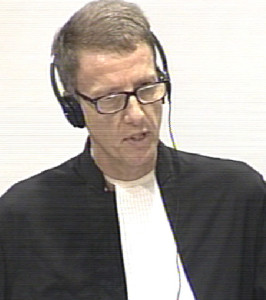
International Nuon Chea Defense Counsel Victor Koppe
After the presence of all parties had been confirmed, Co-Counsel for the Defense Mr. Victor Koppe resumed his questioning of witness Suos Thy. In reference to one of the witness’ statements about Sreang, S-21 photographer, as well as one from from Sreang himself[1] and witness Him Huy[2], Mr. Koppe sought to hear what the witness knew about prisoners being photographed at S-21 before being sent to Prey Sar, the rice fields (or S-24). Mr. Thy did not recall any information on it.
“Was there a principle of secrecy at S-21?” The witness was unable to answer, even after the Co-Counsel read out loud an extract of a 2003 interview by Duch: “Thy did not hold the lists of prisoners being in detention. This reflected the severe compartmentalization of the process, Thy’s section wasn’t supposed to go near the prisoners.”[3]
Mr. Koppe, likely frustrated by the fact that Mr. Thy could not remember a number of events and could not confirm previous statements, pivoted to a line of questioning intended to discredit the witness.
“Mr. Witness, you stated that the lists were not collected and compiled by you. Only Meng was in full control of the list of detainees from S-24. Is that correct?”[4]
“Yes.”
“Yesterday, you were shown several documents, including a list of release from Division 920[5], and two biographies with mentions ‘sent to the rice fields’. You seemed confused and said there were no releases at S-21. Would you say you had limited knowledge, and that […] your statement about no prisoner ever being released is false?”
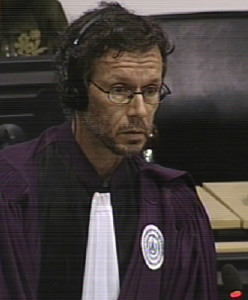
Senior Assistant Prosecutor Vincent de Wilde
Senior Assistant Co-Prosecutor Vincent de Wilde objected on the ground that the interpretation of the word “release” is not clear, to which Mr. Koppe responded that this word, which is in the title of the document, was very straight forward. The objection was sustained by the President, and Mr. Koppe had no choice but to move on, pursing his lips. The Co-Prosecutor then objected to the Defense’s other questions, which were destined to verify previous statements regarding the hierarchy as well as the alleged destruction of files at S-21[6] [7].
Guissé takes over
After a rather aggressive questioning process by Mr. Koppe, the floor was given to Co-Counsel for the Defense of Khieu Samphan, Anta Guissé. First, Ms. Guissé had the witness clarify several of his previous statements, notably that not all his deceased siblings had died under the Democratic Kampuchea regime. However, he still camped his position that no prisoners were released from S-21[8].
In the line of Mr. Koppe earlier aiming at showing the lack of knowledge the witness possessed, Ms. Guissé got this statement by Mr. Thy when questioning him about different lists[9]: “I was not allowed by Hor to inquire into the reasons of the arrest.” Moreover, he stated once again that he never went outside of the main compound of S-21 and was not aware of anything happening outside that perimeter.
Ms. Guissé then inquired extensively about the photography room which was, according to the witness, right next to his office. This interrogation was efficient in the sense that it proved that Mr. Thy did not have access to a lot of information. Indeed, he shared his work space with Hor (his superior), Lann (the young boy who helped him occasionally), the photographers and the guards who brought in the prisoners, but was not allowed himself to go outside.
Vietnamese at S-21: link to the conflict?

Witness Suos Thy
The Co-Defense Lawyer made the distinction between the Vietnamese from the military (prisoners of war) and the ones from the civilian population. After being reminded of one of his 2009 statement, the witness confirmed that to his knowledge, the Vietnamese prisoners of war were arrested and brought to S-21 when the armed conflict between Vietnam and Cambodia started in 1978[10].
The witness then gave more precise answers as to his time in prison in the 1980s, as Ms. Guissé inquired about his promise to be a “good citizen” when he was released. His letter of arrest was from the Cambodian Army but he was not sure which branch – Ms. Guissé was clearly trying to show the Court that Mr. Thy possibly lacked objectivity. Moreover, there was no doubt that the Defense asked about the circumstances of his arrest in order to imply that Mr. Thy’s right to a fair trial was not respected. Though he was not sure if he was detained in Cambodia or Vietnam[11], he was able to specify that he was rather sure it was Vietnam “because there were Vietnamese guards”[12].
This marked the end of Mr. Suos Thy’s testimony. Mr. Thy struggled to follow most of the questions asked by the parties because of memory losses, but for the most part confirmed his previous statements before various authorities, including this Court. The atmosphere was electric as the President announced the beginning of the testimony of Kaing Guek Eav, alias Duch, the former Chairman of the Khmer Rouge at S-21.
Introducing a long known witness: Kaing Guek Eav
The courtroom was buzzing with apprehension as all eyes turn to Kaing Guek Eav, better known as Duch, who was ushered into the courtroom. The President informed Duch to pause between the question and the answer. Duch was born on 17 November 1942 in Peou Veuy Village, Peam Bang Subdistrict, Stong District, in Kampong Thom Province. He currently serves his sentence at Kandal Prison. He has four children with his wife Chhim Sophal alias Rom. Among the introductory questions, the President asked about the witness’ religious beliefs, in order to determine which oath would be appropriate. Duch, though very thin, was relaxed and lively. He took off his glasses and started telling the Court that he respected three different religions: Buddhism, Confucianism and Christianity. “I do not practice any religion myself, but I respect them. [ . . . ] I am even baptized.” Duch’s effusiveness on theology perplexed the audience. When the President asked Duch to take an oath, Duch said that he was willing to do this, and then proceeded:
I solemnly declare that I shall tell the truth, the whole truth and nothing but the truth.
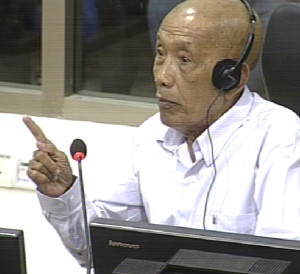
Witness Kaing Guek Eav alias Duch
The President informed the public that Duch had been sentenced by this court for grave breaches of the 1949 Geneva Convention in February 2012. This meant that the witness had to respond to all questions based on the principle of res judicata, even if this led to self-incrimination. The only questions that were not to be asked were those that were outside the scope of the proceedings. Nevertheless, Duch still had rights in relation to self-incrimination, such as the right to a duty counsel – a right that Duch did not exercise. The witness was interviewed in Case 003 by You Bunleng and Frederik Harhoff and was later interviewed by an investigator as assigned by Co-Investigating Judge Bohlander. During this interview, which had lasted three days, he had become sick and was therefore transferred back to the prison facilities. “I did not read it in detail, since I relied on my recollection. […] My recollection still serves me well”, he said. He stated that he had not read the record of the interview with Thomas [Kuehnel] and could therefore not determine whether it was consistent with what he had said during the interview.
Duch tried to draw a certain compassion, repeating that he was “very tired” and needed to take deep breaths before answering questions. The President then handed the floor to the Co-Prosecutors according to Rule 91 bis. The Co-Prosecutors and Civil Party Lawyers had four days in total to examine the witness.
Responsibility and role of Nuon Chea at S-21
Senior Assistant Prosecutor Dale Lysak opened the long awaited testimony by confronting Duch with a statement made by Nuon Chea after Duch had appeared in the court room last time (in April 2012).
Duch is seemingly used to answering questions, as his sharp look went to the whole courtroom while he spoke and he even laughed when confronted with this quote from Nuon Chea:
I would like to inform the Cambodian people that I had never had, any time – ever been responsible for the operation of S-21. What Duch has accused me [of] has been untruthful and very unjust towards me. I have never ordered, I have never received any documents from Duch, and I have never been the superior of Duch.[1]
Mr. Lysak asked Mr. Guek Eav to respond to this statement.
Mr. Prosecutor, I’m surprised by the denial by Bong Nuon. I could not believe that. S-21 Office as well as all the police offices under the Communist Party of Kampuchea were under the leadership of the Party – that is under the orders of the CPK. And the policies of the CPK to smash enemies were produced in 1971 in the Fourth Party Congress […]. That police office in the Special Zone was under the direct leadership of a member of the Standing Committee – that is Vorn Vet. And in my previous testimony during the previous trial, counsel Son Arun put a question to me, asking me to make a statement whether I was with the Ministry of National Defense, that is under Son Sen, and if so, what were the instructions of the Ministry of National Defense to me, and my response at the time was that S-21 was created by Article 8 of the Party Statute. […] I am surprised by the denial by Angkor or Uncle Nuon. Everybody had to respect the principles of the Party decided by the Party Secretary and Deputy Secretary […]. So his denial is nonsense.
Mr. Lysak pressed on the issue and sought more information on Nuon Chea’s involvement: what was his role at S-21 both before Son Sen left to the battlefield and after?
Duch explained the organizational structure of the Party Center:
Pou Nuon was the Deputy Secretary of the Party Center as well as a member of the political office of the Party Center. The word they used at the time was the Stand-By Committee, or Committee 870.
The members of the Party Center were the following: first Pol Pot, second “Pou Nuon”, third Ieng Sary, fourth Vorn Vet, fifth Son Sen and sixth Khieu Samphan. The office of the Party Center was sometimes referred to as the “Party of the Intellectuals” or “the Phnom Penh Group”. From March 1976 – after his appointment as chief of S-21 – until August 15, 1977, he had never met Nuon Chea in person. He only saw Pol Pot when the latter made a presentation of documents and on the day of the national commemoration. Son Sen had, however, repeatedly mentioned Nuon Chea’s name, as well as members of the Standing Committee and members of Committee 870. Duch then gave an example to illustrate the relationship between Son Sen, himself and Nuon Chea: his younger in-law relative was arrested in Kampong Thom and secretly wrote a letter, which Duch had showed to Son Sen.
A moment after, my younger sibling and in-law was sent to S-21. At that time, Son Sen said “keep them for now”.
Son Sen told him that Nuon Chea had instructed him to interrogate them. Duch told the Court that he first questioned them without arresting them. However, his younger in-law “made a mistake later”, so “I had no choice but to make an arrest”. Incriminating Nuon Chea, he said that “Son Sen had to seek permission from either Bong Nuon or Pol Pot”. A document had specified that “the two leaders” had to “know about the situation” so that the other leader could deal with the matter.
Bong Nuon actually instructed me to question my relatives.
After August 15, 1977 – when Son Sen went to the battlefield – “Bong Nuon came to work where I worked”. Nuon Chea came “to work with the lower level, because he was the one who received instructions from the office of the Party Center and to go down to those police offices throughout the country”. The President took the opportunity to adjourn the hearing for the lunch break.
Party Center
After the break, Duch first requested to correct his earlier statement: He first said that he had talked about the Fourth National Congress, but stated now that it had been the Third National Congress. Second, he looked back at the involvement of Nuon Chea at S-21:
It is about a document stating about the involvement of Uncle Nuon in S-21. The confession of Kung Kean alias Ang Veng, that individual was from Division 164. I made an observation to the Co-Investigating Judges that all annotations by Son Sen to the Upper Echelon were sent to Pol Pot. In the heading, those documents state “2 Brother”, but for the document I mentioned this morning, it mentioned “to Brother Nuon Chea”. And why that document was sent to Nuon Chea? It was because Pol Pot was sick and Nuon Chea was acting Prime Minister. This is an evidence proving that Nuon Chea was involved in the task as well and was connected to Pol Pot.
He also referred to an earlier statement he had made about a document that had an annotation. “That annotation I responded at the time was concerning Son Sen, but later on I corrected the statement and stated that in fact that annotation belonged to Nuon Chea. And in every tasks there was involvement by Nuon Chea as well, although Son Sen was to perform certain tasks.”
After this clarifying remarks by Duch, Mr. Lysak inquired about his statement from this morning that included Khieu Samphan in the group of leading cadres, but not Ta Mok and Sao Phim. Duch was visibly physically exhausted and took a few seconds before answering the question. He explained that Ta Mok and Sao Phim were part of the Seven Member Group, which belonged to the Standing Committee of the center. He said that seven members of the Standing Committee were the following:
- Pol Pot
- Brother Nuon (Nuon Chea)
- Ta Phim
- Ta Mok
- Ieng Sary
- Vorn Vet
- Son Sen
However, Brother Phim and Brother Mok did not belong to the political center. Khieu Samphan was not a member of the center. This was from 1975 until 1978. Realizing that he had previously given other information, he said that he was “a bit tired”.
Judge Fenz interjected and said that Duch should inform the Chamber if he had to take a break, since his repeated statement that he was tired was difficult to understand otherwise. Duch explained to the Chamber that he raised his hands to indicate that he was ready to answer, “but please, don’t put more question when I take a deep breath to relax”.
Before letting the Co-Prosecution continue with their questions, Khieu Samphan Defense Counsel Anta Guissé argued that a distinction should be made between post-facto knowledge and knowledge that he had obtained at the time. Mr. Lysak responded by saying that he would have more detailed questions about the source of his knowledge.
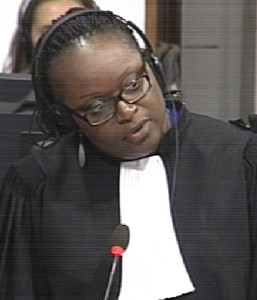
Khieu Samphan Defense Counsel
Mr. Koppe backed his colleague Anta Guissé by saying that it was important to understand “right from the start” what part of his knowledge was contemporaneous. This also applied to who was part of the Standing Committee. Mr. Lysak was visibly upset and said that Duch was head of security and frequently reported from the Party Center: To say that Duch did not know who part of the Standing Committee was at the time, he said, was “ridiculous”. Judge Fenz supported the Co-Prosecution’s standpoint by saying that it had, so far, always been clear where Duch had his knowledge form. The Bench conferred for a few minutes. The President announced the decision: “We cannot really distinguish between the knowledge of the witness and what he has experienced during the later stage – that is the stage of when he was accused”. He advised parties to be mindful about this and to ask about the source of his knowledge. He also advised Duch to respond to the limit of the questions in order to make the questioning less exhausting for him. He would only have to give more detailed answers when follow-up questions were put to him.
Relation between Duch and Nuon Chea
The center section of the public gallery was full with a group of farm villagers. Behind an entire first row of men dressed in white shirts, the second row was almost exclusively filled with women in more colorful attire. When Mr. Lysak articulated the name Nuon Chea, the members of the audience, one after the other, leaned in to pay closer attention. Mr. Lysak sought information about Duch’s first meeting with Nuon Chea: where did it take place and who was there? Duch took the Court back to August 15, 1977. To his recollection, Comrade Phang told him to meet with someone without specifying who. He took the motorbike to go to a school, where he met Nuon Chea on “the upper floor”.
I did not say much at the time. Brother Nuon told me that Brother Khieu went to the battlefield, so I was to work with him from that time.
There was only he and Brother Nuon. “I put in my diary short notes of what happened on that day”. He further recounted “it was clear that I was the subordinate”. The meeting was very short. Mr. Lysak asked whether it was correct that he did not have to “spend hours” to explain “what S-21 was”. Duch confirmed this and said that meetings with Brother Nuon took ten minutes at most.
Treatment of former Lon Nol Officials and Soldiers
Mr. Lysak turned to his next line of questioning. He wanted to know whether Duch knew if Lon Nol officials and soldiers were specifically targeted in the period of 1975 and 1979. Duch said that he was in Amleang on April 17 and invited to join a study session on June 20. On August 15, he was with Nath and informed about Santebal and that he would be the deputy. This was when he started his work. Santebal had been established before his arrival. In Mid-October, he was assigned to perform interrogations. Former officials and soldiers had been arrested already. He was involved in the interrogation of former workers of factory K-10, which produced pepper.
As for Buddhist monks and former officials and soldiers, he said that they “had been screened already” at this point. Mr. Lysak read an excerpt of one of Duch’s earlier statements, in which he had told the investigators that military and police officers had been taken to be smashed by some sub-district committees.[2] Duch confirmed that he had said this. He left Amleang for Phnom Penh on June 20 following orders by Mam Nai. The sub-district committee of Amleang “did the screening”. Mam Nai had relatives in Phnom Penh and knew about the evacuation, which was why he sent Duch to Phnom Penh to tell Mam Nai’s relatives to live with Mam Nai.
Regarding the role of Division 703 in relation to the arrest of former officials, he said that he had learned from “the young men” during self-criticism sessions. A member of a company, Man, said that during the course of the evacuation people had to be moved and would be made moved by shots in the air. Two other people talked about the same matter. Thus, he made his “personal conclusion” that Division 703 was involved in the arrest. The men from Division 703 “spoke at length” about a special unit during the Lon Nol regime. He stressed that he knew about the matter from soldiers.
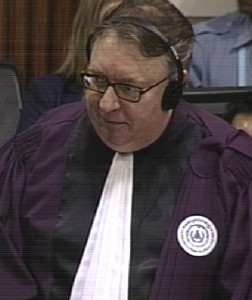
Senior Assistant Prosecutor Dale Lysak
Mr. Lysak again read an excerpt and wanted to know what Pin, Secretary of Division 703, had told him about what had happened to Lon Nol soldiers.[3] Duch corrected Mr. Lysak’s pronunciation. Pin had told him that they “were frank to one another” and had told him that Pol Pot had instructed Pin to monitor “the situation”. Pin had mentioned an order to arrest former soldiers, after which soldiers fled. Chea Kim Eang and another general were arrested and killed later, after which the situation seemed to “quiet down”.
Mr. Lysak showed a document to the witness from Comrade Pin of the Special Zone of June 4, 1975, that identified 17 Lon Nol soldiers that had to be smashed.[4] Mr. Lysak asked whether this was the same Pin. Duch replied that he could not recall which Pin came from a Special Zone, but said that it could be Pin from Division 703. He further recounted that Division 12 was part of the south part of the Special Zone. Later, Division 703 was created. He did not recognize any of the 17 people on the list.
Next, Mr. Lysak wanted to know whether he remembered being assigned to look for documents related to Lon Nol soldiers in Kampong Thom. Duch answered that he collected documents from the military headquarters, the residence from Lon Nol and another house. He said that these documents should be used for further investigations. Some documents existed in French and English. “I also gathered documents from a location such as a Party’s house from the former Lon Nol government. And I also gathered documents from the judicial headquarters, that is the national police commissariat.”
Adding to the list of documents, Mr. Lysak provided a report to Duch and asked him whether he had prepared this document in 1975.[5] Duch explained that Nath, who was referred to in the document as Brother 03, had requested this document. It was a three-page document which, according to Duch, proved that only Nath had the authority to arrest people. Visibly agitated, Duch said that he had tried to explain this to the Co-Investigating Judges. He did not know whether Nath was still referred to as Brother 03 after having been removed from S-21. He was assigned to the Ministry of Foreign Affairs later on.
In the previous regime – before 1970 – Khum Tat was a teacher of Khmer literature who had, according to Duch’s account, “strongly collided” with the Lon Nol government and had wanted to arrest Khieu Samphan. He became the principal of a school in Kampong Chhnang, but became part of a committee of the coup d’état of Lon Nol. Nath was “busy trying to find his further fiancé”, who he found at Baray.
Mr. Lysak wanted to know what the party policy was toward the arrest of these people.[6] Duch explained that the 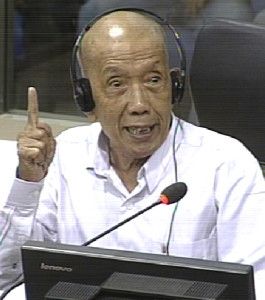 policy was issued in 1971 during the Third Party Congress “that all enemies had to be smashed”. Another policy was issued in 1973: this concerned a “special class”, which included former monks (who taught people about karma) and soldiers and policemen. “These people held guns in their hands and killed people”. These were considered enemies. He did not know Nos Vat – Nos Vat met Lon Nol officials often, he said.
policy was issued in 1971 during the Third Party Congress “that all enemies had to be smashed”. Another policy was issued in 1973: this concerned a “special class”, which included former monks (who taught people about karma) and soldiers and policemen. “These people held guns in their hands and killed people”. These were considered enemies. He did not know Nos Vat – Nos Vat met Lon Nol officials often, he said.
Probing further on the issue, Mr. Lysak wanted to know what happened to those who hid former Lon Nol officials. Duch answered that he did not know and that “screening happened”. This prompted Mr. Lysak to confront Duch with his own statement, in which he had mentioned executions and arrests.[7] Duch corrected Mr. Lysak: “Mr. Prosecutor, the pronunciation is wrong. It is Nou Tho. And Soeung was the commander who arrested Nou Thor.” He had learned about this arrest from his wife, who was “part of the West”.
At this point, the President adjourned the hearing for a break.
Treatment of Lon Nol soldiers – arrests
Starting in the last session, Mr. Lysak asked whether Duch remembered a deputy governor of Phnom Penh or Daun Penh district called Sar Phan and whether he knew what happened to him after April 1975. The witness could recall Sar Phorn, who was implicated by someone called Mar Dy – this person had attempted to flee. Duch had taken Mar Dy’s confession to Son Sen. After the fall of Phnom Penh, Son Sen had used his assistant Nath to arrest Sar Phorn. The interrogation was arrested at the residence of Prince Monireth. This was the time that Duch “started to know” about the Special Prison.
Mr. Lysak read out Duch’s answer to a question in a previous hearing, in which he had said that Nath took him to the Special Prison at the Monireth residence, in which Sar Phorn had written his confessions.[8] Duch confirmed this. He went to this location and saw Phorn briefly. He also saw a person called Hang who read the confession. Duch stressed that he did not engage in interrogations of former Lon Nol soldiers. When Duch said that he could not remember the purpose of these interrogations, Mr. Lysak responded that he had admitted in Case 001 having annotated Phorn’s confessions, saying “our purpose is we want the actual location of the group, their names, their physical description”.[9] Duch confirmed that this was their aim of their interrogations.
Next, a report relating to a prisoner called Lang Kring was presented to Duch and asked whether he recognized the signature on the right hand corner of the document.[10] Duch replied that it was Nath’s signature, who was also known as Saen. This was the name of a dead soldier initially. At that time, Duch explained, he had not yet been working for the Center. “As for Nath, he was a little bit liberal in arresting people”. Duch also recognized the handwriting in the upper left corner: he said that it was Son Sen’s handwriting. Mr. Lysak asked whether he was involved in the arrest of the workers from a paper factory, which Duch confirmed:
I conducted the interrogations of the former factory workers.
He conducted the interrogation, he said, only with one worker. The workers were mostly from Sector 25, which included Angkor Thuom and Kien Svay. “To my recollection, prisoners at Ta Khmao were smashed separately from others”. Nath was removed from S-21 in March, but was still entitled to enter S-21 to conclude his work at that location and assist Hor. This prompted Mr. Lysak to refer to one of Duch’s previous testimonies. During this hearing, he had testified that he brought prisoners from Ta Khmao to the houses where they first began operating.[11] Duch confirmed this. “During the initial operation of the center, I was assigned by Ta Nath to Chea Kim Eang’s residence, and prisoners were detained to the south of that residence. Young men were tasked with the interrogation of these prisoners”. To his recollection, most of these workers were former workers.
Presenting yet another document to the witness, Mr. Lysak referred to a list that was titled Names of Prisoners Who Died at S-21-Kor. This list named 159 people.[12] Duch said that he did not know about S-21-Kor (or S-21-C). “When I was [overall] in charge, there was [an] office in the field, but when you speak of B or C, I’m confused now.” He was unable to give more information on this matter when Mr. Lysak pushed the matter further. To trigger the witness’s memory, Mr. Lysak gave Duch another list. This list was dated April 11, 1976, and contained a daily total of the prisoners at S-21.[13] Mr. Lysak said that 262 prisoners were located in S-21-A, 396 in S-21-C, and a total of 658 prisoners. Duch recounted that Hor had drawn up these numbers and that it was consequently beyond his own knowledge.
Duch was first assigned to work at Chea Kim Eang residence, but requested to be able to work at the school.
Medical experiments and live surgery
Mr. Lysak directed the attention to the list of 159 people who were smashed.[14] He pointed to number 39, and asked whether he remembered a person called Ban Ouch Nil Pich. Duch said that they were former Issarak fighters and given titles by King Sihanouk. This was not in the vicinity of S-21. This person, to Duch’s knowledge, was not interrogated, but that Nath smashed him because of his former opposition to the regime:
Nath did not dare leave him alive.
He confirmed that Ban Ouch was Nath’s uncle. He was killed, because “Ouch was a famous person”. He had been a leader of the Issarak movement, but had defected to Sihanouk later on. This also applied to Chhoun. Mr. Lysak asked about numbers 44 until 49, 135 and 136, 149 and 153 until 155. Duch confirmed having seen these people on the list, but did not know the surname Long.
Mr. Lysak said that the children of Thach Chea were listed as well and wanted to know who Thach Chea, his wife and children were. Duch said that he was a former professor, as was his wife. He was promoted to be a state secretary later on. The President interrupted the witness and said that they were talking about Thach Chea and not Long Boreth. Duch recounted that he had seen Thach Chea’s wife walking with her husband in a school.
There was a conflict between Duch and Ta Nath in relation to Thach Chea’s wife. One day, “a young man requested [to use her] to teach a medic” how to do surgery, but Duch denied this request. Days later, Nath convened had a meeting. Ta Nath made a report as if this medical experiment really taken place and that later on, the wife had died. The four children “were pretty young’. Mr. Lysak confronted the witness with his own statement.[15] Duch reiterated that he had refused the request to “use Thach Chea’s wife” for this medical experiment. Their superior blamed Nath for this. This superior was Son Sen. He confirmed that Son Sen criticized them for using a famous person’s wife for this, but not for using a person in general. Duch then said that “the children would be taken away and killed as well” when their parents were arrested. Thach Chea’s wife was a few years older than Duch.
Religion, an unfavorable criteria
Mr. Lysak then turned to numbers 51 to 53 on the list (see footnote 14) and asked why the catholic religion of these executed persons was mentioned in the list. At this point, Mr. Koppe objected for the first time in the afternoon and said that the question led to speculation. Mr. Lysak rejected this argument and said that it was legitimate to ask the deputy chairman of the prison why their religion was mentioned. The objection was overruled. Duch said that “this is a separate matter that I was not aware of”. To give information nonetheless, Duch recounted a meeting with Ta Nath. Duch remembered that Nath had said that they had found CIA agents in Sector 31 or 33 and that CIA agents would stay agents. He had asked why they had not found CIA agents in S-21 if they could find CIA agents in other sectors. It had been asked why they “did not even resolve to beat them up” and to “try harder” to find CIA agents. He then explained that the catholic religion was understood as a reactionary religion. There was one survivor who lived near a hospital.
“The rest died”. Thus, “I believe that the two religions were seen as reactionary religions”. When Duch finished his sentence, the President adjourned the hearing for the day. It will continue tomorrow, June 8, 2016, at 9 am with Duch’s testimony.
Footnotes: Suos Thy
[1] Interview with DC-Cam, E3/9230, at 00337985 (EN), 00052031 (KH), 00280259 (FR).
[2] Him Huy, 5/5/2016, at 10h43 and 10h45: talks about people arriving; “Ta Hor assigned me and other men to the job; sending men to Prey Sar, and there were a number of prisoners taken at Tuol Sleng.”.
[3] E3/7637, at 00229033 (KH), 00344703 (FR), 00185875 (EN).
[4] E3/7466, at 10h48.
[5] E3/8648.
[6] E3/7466, at 15h39: Duch saying that Suos Thy was not under his direct orders; E3/7466, at 11h04: “there was no plan to destroy any document.”
[7] E3/1684, at 001918835 (KH), 00192685 (EN), 00357268 (FR); E3/1684, at 00192676 (EN). David Chandler’s research on the account of the number of victims who went through S-21.
[8] E3/7603, at 00392492 (FR), 00145602 (KH), 00146798 (EN).
[9] E3/965, at 00068840 (KH), 00324630 (FR), 00316312 (EN) and 00068841 (KH), 00324631 (FR), 00316313 (EN).
[10] E3/7466, at 11h42 and 14h45.
[11] E3/9320, at 00280501 (FR), 00052003 (KH), 00909161 (EN).
[12] E3/9320, at 00280502 (FR), 00052004 (KH), 00909161-62 (EN).
Footnotes Kaing Guek Eav alias Duch
[1] 18 April 2012, at 09:13.
[2] July 7, 2002, E3/529, at 00329130 (EN), 00095693 (KH), 00327360 (FR).
[3] E3/429, at 00403909 (KH), 00403920-21 (EN), 00403932-33 (FR).
[4] E3/832.
[5] E3/1052.
[6] March 26, 2012, E1/53.1, at 14:19-14:20.
[7] E3/429, at 00403909 (KH), 00403921 (EN), 00403933 (FR).
[8] April 22, 2009, E3/524, at 15:25.
[9] April 28, 2009, at 15:23-15:27; E3/5794.
[10] E3/3652.
[11] April 22, 2009, E3/524, at 15:28.
[12] E3/1539.
[13] E3/8493.
[14] E3/1539.
[15] June 16, 2009, E3/5800, at 15:59-16:06.
Featured Image: Witness Kaing Guek Eav alias Duch (ECCC: Flickr).

[…] [1] Awaited Testimony of Former Head of S-21 Duch Begins, The Cambodia Tribunal Monitor, June 7, 2016 […]